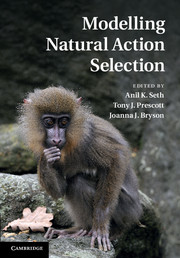Book contents
- Frontmatter
- Contents
- Foreword
- Preface
- Contributors
- 1 General introduction
- Part I Rational and optimal decision making
- Part II Computational neuroscience models
- 9 Introduction to Part II: computational neuroscience models
- 10 Action selection and refinement in subcortical loops through basal ganglia and cerebellum
- 11 Cortical mechanisms of action selection: the affordance competition hypothesis
- 12 Toward an executive without a homunculus: computational models of the prefrontal cortex/basal ganglia system
- 13 Hierarchically organised behaviour and its neural foundations: a reinforcement-learning perspective
- 14 The medial reticular formation: a brainstem substrate for simple action selection?
- 15 Understanding decision-making deficits in neurological conditions: insights from models of natural action selection
- 16 Biologically constrained action selection improves cognitive control in a model of the Stroop task
- 17 Mechanisms of choice in the primate brain: a quick look at positive feedback
- Part III Action selection in social contexts
- Index
- Plate section
- References
16 - Biologically constrained action selection improves cognitive control in a model of the Stroop task
from Part II - Computational neuroscience models
Published online by Cambridge University Press: 05 November 2011
- Frontmatter
- Contents
- Foreword
- Preface
- Contributors
- 1 General introduction
- Part I Rational and optimal decision making
- Part II Computational neuroscience models
- 9 Introduction to Part II: computational neuroscience models
- 10 Action selection and refinement in subcortical loops through basal ganglia and cerebellum
- 11 Cortical mechanisms of action selection: the affordance competition hypothesis
- 12 Toward an executive without a homunculus: computational models of the prefrontal cortex/basal ganglia system
- 13 Hierarchically organised behaviour and its neural foundations: a reinforcement-learning perspective
- 14 The medial reticular formation: a brainstem substrate for simple action selection?
- 15 Understanding decision-making deficits in neurological conditions: insights from models of natural action selection
- 16 Biologically constrained action selection improves cognitive control in a model of the Stroop task
- 17 Mechanisms of choice in the primate brain: a quick look at positive feedback
- Part III Action selection in social contexts
- Index
- Plate section
- References
Summary
Summary
The Stroop task is a paradigmatic psychological task for investigating stimulus conflict and the effect this has on response selection. The model of Cohen et al. (1990) has hitherto provided the best account of performance in the Stroop task, but there remains certain key data that it fails to match. We show that this failure is due to the mechanism used to perform final response selection – one based on the diffusion model of choice behaviour (Ratcliff, 1978). We adapt the model to use a selection mechanism which is based on the putative human locus of final response selection, the basal ganglia/thalamo-cortical complex (Redgrave et al., 1999). This improves the match to the core human data and, additionally, makes it possible for the model to accommodate, in a principled way, additional mechanisms of cognitive control that enable better fits to the data. This work prompts a critique of the diffusion model as a mechanism of response selection, and the features that any response mechanism must possess to provide adaptive action selection. We conclude that the consideration of biologically constrained solutions to the action selection problem is vital to the understanding and improvement of cognitive models of response selection.
Introduction
The Stroop task provides a thoroughly explored experimental framework for investigating cognitive aspects of selection. In this task, subjects have to name the ink colour of word-strings which can themselves spell out the name of a colour. When the ink-colour and the word-name contradict each other response selection is slowed and is more prone to error (compared to conditions where the word-name is neutral or is congruent with respect to the ink-colour). This is ‘the Stroop Effect’. A simple reversal of the task, that of reading the word-name and ignoring the ink-colour, does not produce an opposite effect (a ‘reverse Stroop’ effect).
- Type
- Chapter
- Information
- Modelling Natural Action Selection , pp. 363 - 389Publisher: Cambridge University PressPrint publication year: 2011



